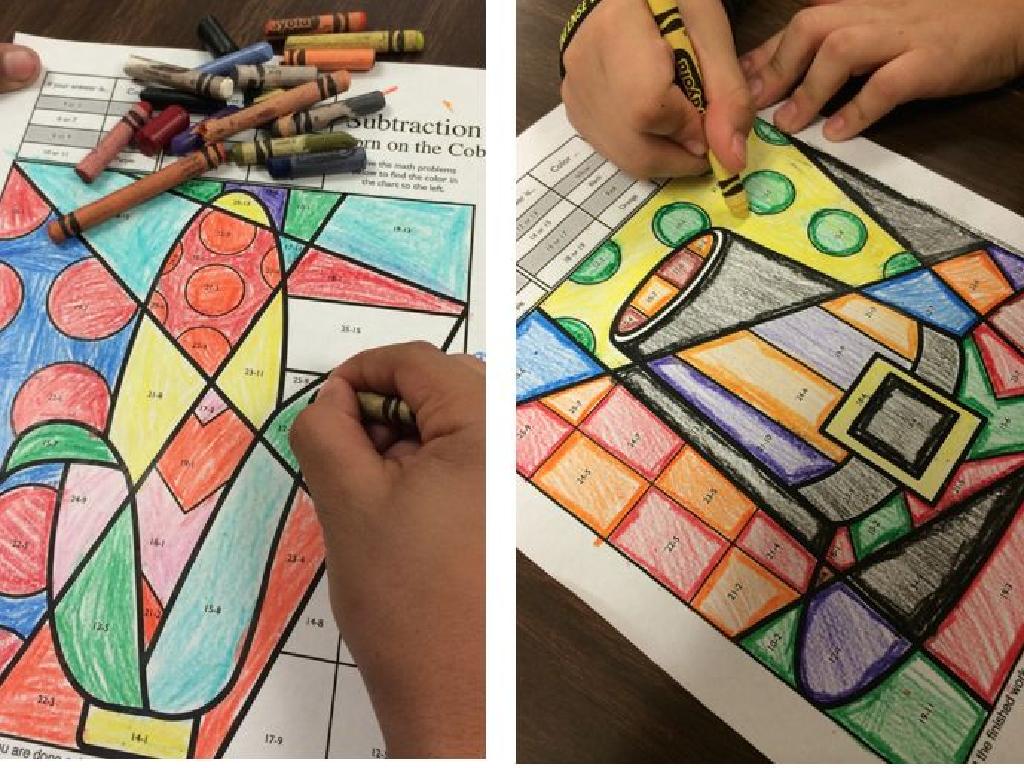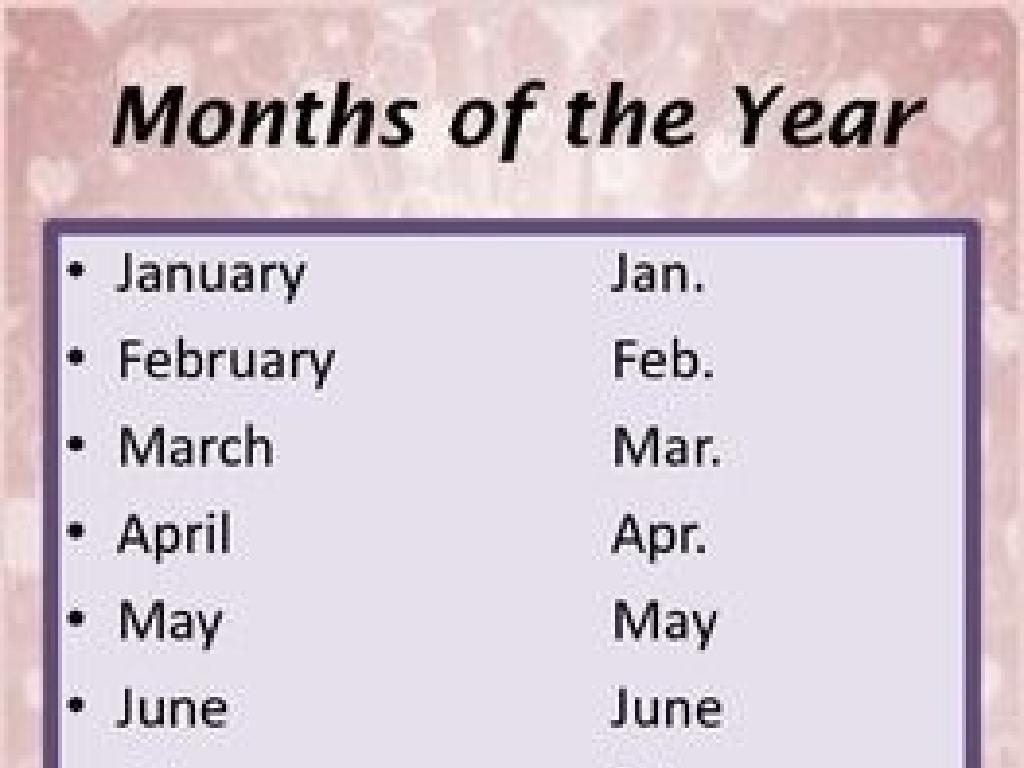Put Numbers In Order - Up To 100
Subject: Math
Grade: First grade
Topic: Comparing Up To 100
Please LOG IN to download the presentation. Access is available to registered users only.
View More Content
Welcome to Number Order!
– Greetings First Graders!
– Learning to order numbers
– Understand how to sequence numbers
– Arranging numbers small to large
– Start with lower numbers and increase
– Practice with numbers up to 100
– Use number lines and counting objects
|
This slide introduces first graders to the concept of ordering numbers. Begin by greeting the students and creating an engaging and welcoming environment. Explain that ordering numbers is like lining up in order from the shortest to the tallest. Start with simple examples using smaller numbers and gradually introduce larger numbers up to 100. Use visual aids like number lines and physical objects to help students visualize the concept. Encourage participation by asking students to arrange groups of numbers and to identify which number comes first or last. This foundational skill will aid in their understanding of number sequences and prepare them for more complex math concepts.
Putting Numbers in Order Up to 100
– Understanding number order
– It means arranging numbers from least to greatest.
– Numbers are like a line-up
– Imagine standing in line from the shortest to the tallest.
– Order: smallest to largest
– Just like we stand in line, numbers line up from 1, 2, 3, to 100.
– Using a number line
– A number line is a tool that helps us see and understand the order of numbers.
|
This slide introduces the concept of ordering numbers, which is fundamental in understanding number sequences and place value. Relate the concept to a familiar activity, such as lining up for recess, where there is a clear start and end point. Emphasize that numbers, like students in a line, have a specific order from the smallest to the biggest. Introduce the number line as a visual aid that can help students see this order clearly. Encourage students to practice by placing random numbers on a number line and arranging them in order. This will help them visualize and grasp the concept of numerical order.
Ordering Numbers with a Story
– Imagine friends in height order
– Picture 5 friends from shortest to tallest
– Identify the tallest and shortest
– The friend at the front is shortest, at the back is tallest
– Line up numbers like friends
– Numbers can stand in line too, from smallest to biggest
– Practice ordering numbers
|
This slide introduces the concept of ordering numbers by using a relatable story about friends lining up by height. It’s a visual and intuitive way for first graders to grasp the idea of sequencing. Start by asking the students to visualize their friends standing in a line from the shortest to the tallest and then to identify who would be at the front and the back of the line. Then, transition to explaining that numbers, just like friends, can be lined up from the smallest to the largest. Encourage the students to think of numbers as people in a line and decide where each number should go. For the activity, provide a set of numbers and have the students arrange them in order. This will help them understand the concept of numerical order in a fun and engaging way.
Ordering Numbers 1 to 20
– Start with numbers 1 to 20
– Counting together as a class
– We’ll count aloud from 1 to 20
– Place numbers in correct order
– Use number cards to visualize sequence
– Practice makes perfect
– Repeat activity to build confidence
|
This slide introduces the concept of numerical order using a manageable set of numbers for first graders. Begin by engaging the class in a counting exercise from 1 to 20, ensuring they understand the sequence. Use physical number cards or a number line on the board to help students visualize the correct order. Encourage participation by having students come up and place numbers in the correct sequence. Reinforce the activity with practice, allowing students to become confident in their ability to order numbers. This foundational skill will be crucial as they progress to ordering larger numbers.
Ordering Numbers from 21 to 50
– Understanding bigger numbers
– Numbers beyond 20 can be big, but they follow the same rules.
– Sorting numbers 21 to 50
– Let’s line up numbers like we’re lining up for lunch!
– Smallest numbers lead the way
– Think of numbers like a race where the smallest one wins.
– Practice makes perfect
|
This slide aims to build on the students’ existing knowledge of numbers by introducing them to a larger set, from 21 to 50. Emphasize that the same principles apply when ordering these bigger numbers as with smaller ones. Use analogies that resonate with first graders, such as lining up or racing, to explain the concept of numerical order. Encourage them to practice by arranging number cards or writing numbers in order. Activities can include number line creations, ordering number puzzles, and interactive games that reinforce the concept of sequencing numbers. Remember to praise their efforts as they grasp ordering larger numbers.
Arranging Numbers 51 to 100
– Time for a big challenge!
– Arrange numbers 51 to 100
– Put these numbers in sequence like a number line
– Look for patterns in numbers
– Numbers ending in 0 come after 9, like 60 after 59
– Practice makes perfect
– The more you practice, the quicker you’ll get it!
|
This slide is designed to encourage first graders to tackle the challenge of arranging numbers from 51 to 100. Emphasize the importance of looking for patterns, such as the sequence of tens and ones, to make this task easier. Encourage them to think of the numbers as a continuation of a number line they are already familiar with. Provide examples of patterns, like how each new ten’s place number follows a 9 (e.g., 60 comes after 59). During class, you can turn this into an activity by giving students a mixed set of number cards from 51 to 100 and asking them to arrange them in order. Offer plenty of praise as they work through the challenge, reinforcing that practice will help them improve their number sequencing skills.
Using a Number Chart to Order Numbers
– A 100-chart shows number order
– Each row begins with a larger number
– Find and color numbers 1-100
– Use different colors for each row to see the pattern
– Practice number sequencing
– Helps understand how numbers grow step by step
|
This slide introduces the concept of ordering numbers using a 100-chart, which is a visual tool that helps first graders understand the sequence of numbers up to 100. The chart is organized in rows, with each row starting with a number that is one ten bigger than the number at the start of the previous row. During the activity, students will find and color the numbers from 1 to 100, which will help them recognize patterns and understand how numbers progress. Teachers should guide students through the activity, ensuring they understand that each row represents a new set of ten and that the sequence continues to the right and then down to the next row. This hands-on activity is designed to reinforce their counting skills and number recognition.
Class Activity: Building Our Number Train
– Each student receives a numbered car
– Arrange cars to form a number train
– Place your car next to the number just before yours
– Ensure numbers are in correct order
– Check the sequence: 1, 2, 3, … up to 100
– Work together to complete the train
– Help each other find the right spot for your car
|
This activity is designed to help first graders understand numerical order through a fun and interactive exercise. Distribute paper cars with numbers on them to each student. The task is to arrange the cars in ascending order to form a ‘number train’. It’s a hands-on way to visualize sequencing and practice counting. As a teacher, guide the students to find the correct position for their car, ensuring that everyone participates. Encourage them to help their classmates, fostering a collaborative learning environment. Possible variations of the activity could include arranging the cars in descending order, skipping numbers for skip counting practice, or even identifying missing numbers in a sequence.
Great Work on Number Order!
– Excellent job ordering numbers
– Numbers line up small to big
– Just like a queue, smallest at the front!
– Practice with a number line
– Draw a line with numbers and practice
– Use a 100-chart at home
– A chart with 1 to 100 helps you see the order
|
This slide is meant to congratulate the students on their hard work and to reinforce the concept of numerical order. Emphasize that numbers are organized from the smallest to the largest, similar to how people or items are arranged in a queue. Encourage students to continue practicing at home using a number line, which they can create with a piece of paper and a ruler, or by using a 100-chart, which visually displays numbers from 1 to 100 in a grid format. This will help them to better understand the sequence of numbers and to recognize patterns within the number system. Offer praise and positive reinforcement to motivate them for further practice.






